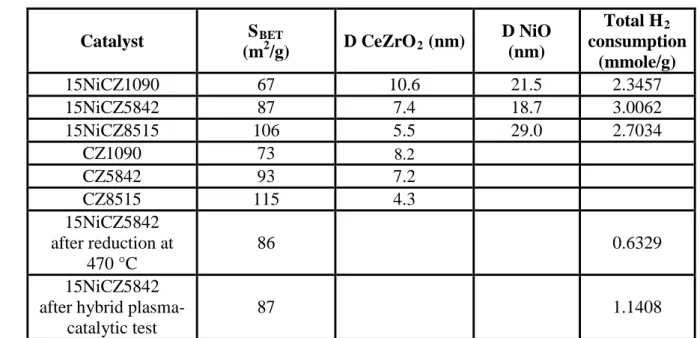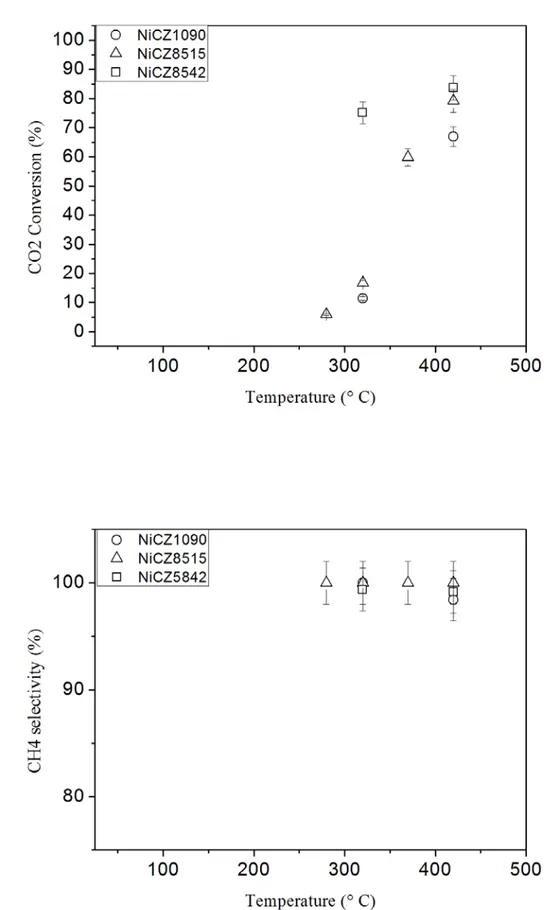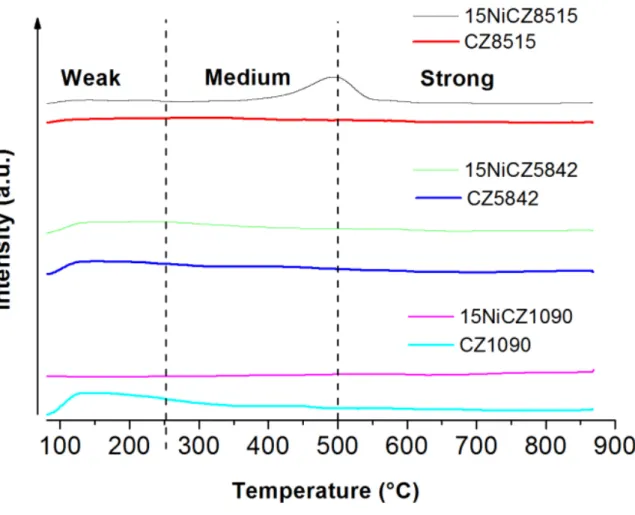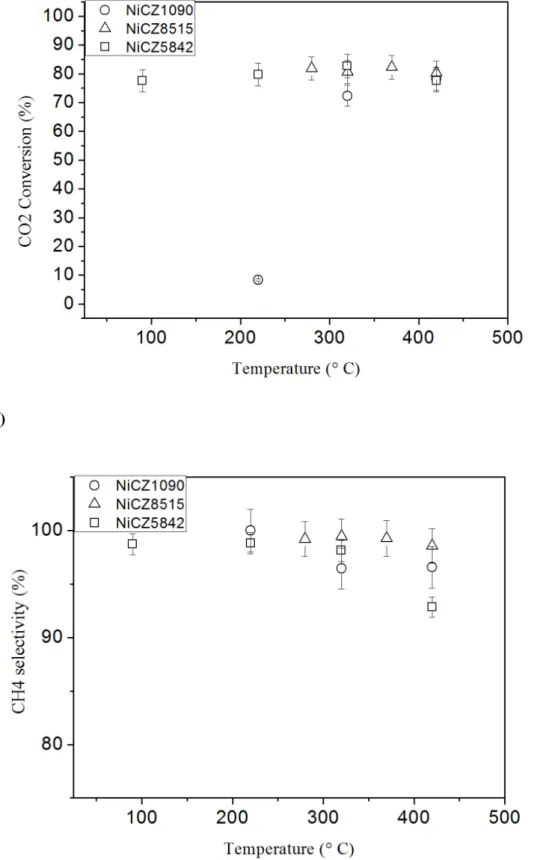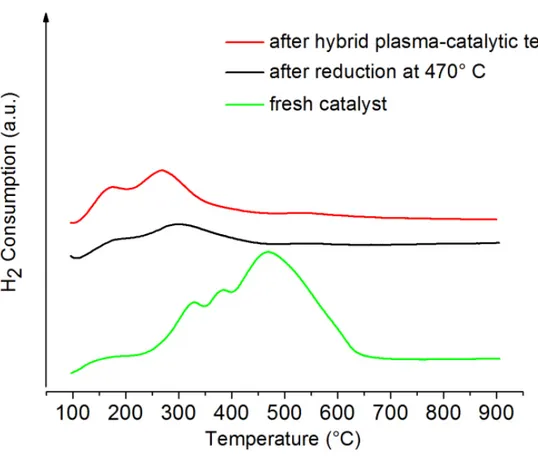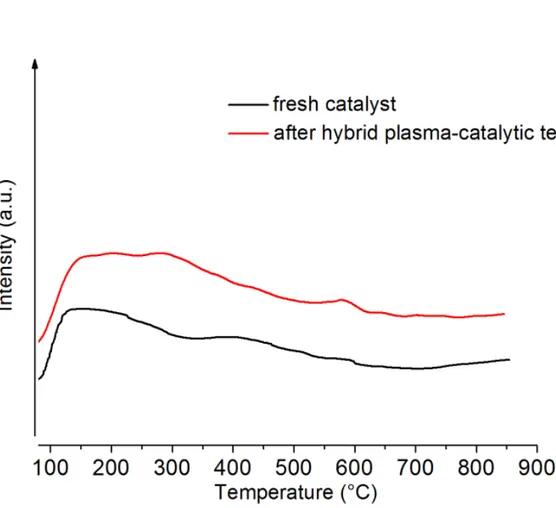HAL Id: hal-01289154
https://hal.sorbonne-universite.fr/hal-01289154
Submitted on 16 Mar 2016HAL is a multi-disciplinary open access archive for the deposit and dissemination of sci-entific research documents, whether they are pub-lished or not. The documents may come from teaching and research institutions in France or abroad, or from public or private research centers.
L’archive ouverte pluridisciplinaire HAL, est destinée au dépôt et à la diffusion de documents scientifiques de niveau recherche, publiés ou non, émanant des établissements d’enseignement et de recherche français ou étrangers, des laboratoires publics ou privés.
Hybrid plasma-catalytic methanation of CO2 at low
temperature over ceria zirconia supported Ni catalysts
Magadalena Nizio, Abdulkader Albarazi, Simeon Cavadias, Jacques
Amouroux, Maria Elena Galvez, Patrick da Costa
To cite this version:
Magadalena Nizio, Abdulkader Albarazi, Simeon Cavadias, Jacques Amouroux, Maria Elena Galvez, et al.. Hybrid plasma-catalytic methanation of CO2 at low temperature over ceria zirconia supported Ni catalysts. International Journal of Hydrogen Energy, Elsevier, 2016, 41 (27), pp.11584-11592. �10.1016/j.ijhydene.2016.02.020�. �hal-01289154�
Hybrid Plasma-catalytic methanation of CO
2at low temperature
over Ceria Zirconia supported Ni catalysts
Magadalena Nizioa,b,c, Abdulkader Albarazia, Simeon Cavadiasa, Jacques Amourouxa, Maria Elena Galvezb,c, Patrick Da Costab,c*
a
Institut de Recherche de Chimie Paris, Equipe 2PM, 11 rue Pierre et Marie Curie, 75005 Paris, France
b
Sorbonne Universités, UPMC, Univ. Paris 6, Institut Jean Le Rond d’Alembert, 2 place de la gare de ceinture, 78210 Saint Cyr L’Ecole, France
c
Institut Jean Le Rond d’Alembert, CNRS, UMR 7190, 2 place de la gare de ceinture, 78210 Saint Cyr L’Ecole, France.*corresponding author : patrick.da_costa@upmc.fr
ABSTRACT
A hybrid plasma-catalytic system was used in for the hydrogenation of carbon dioxide (CO2) into methane (methanation) at the atmospheric pressure and a very low temperature using a dielectric barrier discharge (DBD) plasma reactor packed with Ni-CexZr1-xO2 catalysts. Three catalysts were prepared by a conventional wet impregnation method, using 15 wt% of Ni loading over ceria-zirconia mixed oxides having different Ce/Zr ratios. The physico-chemical features of both catalysts and supports were evaluated by means of X-Ray Diffraction (XRD), Temperature-Programmed Reduction of H2 (H2-TPR), Temperature Programmed-Desorption of CO2 (CO2-TPD) and Transmission Electron Microscopy (TEM).
the temperature range of 90-420°C. The hybrid plasma 15NiCZ5842 catalyst combination was found to efficiently convert CO2 into methane even at low temperature. Indeed, CO2 conversions as high as 80%, together with 100% selectivity toward methane was measured in the presence of plasma at 90°C. On the contrary in the absence of plasma, the same conversion and selectivity were only achieved at much higher temperatures around 300 ºC, for the same catalyst.
1. Introduction
The increasing concern on the greenhouse gases emissions (mainly CO2) forces our society to seek for efficient options towards the stabilization of atmospheric CO2 concentrations in overall zero-emissions scenario, considering CO2 recycling, reutilization as an alternative to its geological storage. Catalytic methanation of CO2 stands as a perspective technology for such purpose [1,2].
CO2 + 4H2 = CH4 + 2H2O (ΔH = - 165 KJ/mol) In addition the limited resources of oil and natural gas, together with the increasing energy demand, forces us to seek for each time more efficient and cleaner energy production alternatives. Hydrogen has been recently considered as promising energy carrier. However, there are several problems inherent to the utilization of H2, from its transportation to its distribution. The transformation of the H2 molecule by fixing into a carbon-containing compound, i.e. CH4, will offer the possibility of using the infrastructure of natural gas transportation network.
Methanation represents both a feasible approach contributing to the reduction of the emissions of CO2 and a way of transforming hydrogen into a conventional energy carrier. Though many different metals have been used to catalyze the methanation process, the
catalysts mostly based on Group VIII metals, such as Ni and Ru and supported on various porous materials, are among the most commonly studied systems, since they allow achieving considerable methanation rates [3-8]. Ni-based catalysts have been widely investigated, because of their good compromise between high activity and low price [7]. The interaction between the metal and support also plays a very important role in catalyst performance [9] and a key role in the active site dispersion, stability and activity [10]. Ocampo et al. [11] evaluated CO2 methanation activity of Ni-ceria-zirconia and revealed that Ni-ceria-zirconia exhibited excellent catalytic activity and stability during 150 h on stream. Such outstanding performance was due to the high oxygen storage capacity of ceria-zirconia oxides and together with the presence of highly dispersed nickel. Other studies [12] claimed that CO2 methanation activity on Ni-ceria-zirconia was related to the particular interaction between Ni2+ cations and the ceria-zirconia support. Cai et al. [1] studied fractional-hydrolysis-driven formation of non-uniform dopant concentration catalyst nanoparticles of Ni/CexZr1-xO2 in methanation of CO2 and showed that a structure with Ce and Ni enriched at the surface improved the conversion of carbon dioxide. Despite the encouraging results observed for Ni-catalysts at around 300°C and atmospheric pressure, the presence of water in the products leads to the sintering of Ni particles, which is the main reason for catalysts deactivation. However, conversion becomes negligible below 250°C. At higher temperatures, (>420 ºC), concomitant secondary reactions favor the CO+H2 formation, thus considerably decreasing the selectivity towards the methane formation.
A hybrid combination of catalysts with Dielectric Barrier Discharge plasma (DBD) may allow us to overcome all the above-mentioned drawbacks. Moreover, DBD catalytic reactors require usually only very low consumption of electricity power, less than 12kJ/mole of CH4 and, at the same time, they meet all the requirements for large volume methane production [13]. Non-thermal plasma, producing a wide variety of active species such as electrons, ions
and radicals, has been applied to the methanation of CO [14-16]. Song et al. [16] have investigated the production of synthesis gas with the use of a Ni catalyst packed in dielectric barrier discharge (DBD) reactor, and reported that the CO selectivity considerably increased with the application of plasma. Furthermore, Mok et al. found that non-thermal plasma can enhance the rate of catalytic methanation of CO using a coupled plasma catalytic process using a Ni-Zeolite catalyst [3]. No studies in the existing literature have reported so far the influence of working with DBD plasmas for enhancing the catalytic performance in CO2 methanation.
In the present work we present a hybrid plasma-catalytic methanation process in allowing low temperature conversion of CO2 to methane. This combined Ni-CexZr1-xO2 catalysts and DBD plasma lead to the high yields necessary for this process to became economically feasible. Structural and chemical characterization was performed on selected Ni-CexZr1-xO2 catalysts prior and after methanation reactions in order to assess the differences in catalytic behavior and durability.
2. Experimental
2.1. Catalysts synthesis
Three catalysts were prepared by a conventional wet impregnation method, commercial ceria-zirconia mixed oxide (CexZr1-xO2) with different Ce/Zr ratios: Ce0.1Zr0.9O2, Ce0.58Zr0.42O2 and Ce0.85Zr0.15O2 (Rhodia Solvay) were used a support These supports were impregnated with an aqueous solution of nickel nitrate hexahydrate (Ni(NO3)2∙6H2O, Aldrich) as metal precursor. The Ni loading for all catalysts was fixed as 15 wt%, in all the cases. After the impregnation, the catalysts were dried overnight at 100 °C
and subsequently calcined at 550 °C for 4 h in air. The final catalysts were respectively denoted as 15NiCZ1090, 15NiCZ5842 and 15NiCZ8515.
2.2. Catalysts characterization
The specific surface areas of both catalysts and supports were determined by physisorption of N2 at 77 K using a Quantasorb Jr. dynamic system equipped with a thermal conductivity detector (TCD). The specific surface areas were calculated using the BET method. The reducibility of nickel and ceria-zirconia mixed oxide was evaluated by Temperature Programmed Reduction (H2-TPR) in a H2 flow system (BEL Japan BELCAT-M). In the presence of 5 %vol. H2 /Ar, about 50 mg of each material were heated up to 950 °C at a heating rate of 7.5 °C/min. Before TPR measurements, catalysts were pre-treated at 400 °C under helium flow for 1 h and then cooled down to 100 °C. The H2 consumed was monitored by a TCD detector. Temperature programmed desorption of CO2 (CO2-TPD) was carried out in a flow system (BEL Japan BELCAT-M equipped with a TCD detector) using a 10 %vol.CO2 /He gas mixture. About 50 mg of each catalyst was loaded in a quartz U-tube and flushed at 500 °C for 1 h in He flow and cooled to 80°C. Then, they were exposed to a gaseous mixture of CO2 (10 vol.%)/helium for 1 h at 80°C in order to adsorb CO2. Helium was then flown for 15 minutes in order to desorb the physically adsorbed. Temperature programmed desorption (TPD) of CO2 was carried out heating the samples at 10 °C/min up to 950 °C under He flow. The desorbed CO2 was measured with the aid of the TCD detector. CO2 desorption measurements were performed on the catalysts reduced in 5 %vol. H2/Ar for 2 hours at 470°C. The X-ray diffraction (XRD) patterns were acquired in a XRD (Empyrean diffractometer from PANalyticla), using Cu-Kα anode operated at 45 kV and 40 mA. The scanning range was set from 3° to 90° (2 , with a step size of 0.01°. High-resolution
transmission electron microscopy (HRTEM) images were acquired on a JEOL JEM 2011 equipped with LaB6 filament, operating at 200 kV on reduced and used catalysts.
2.3. Experimental set-up and methanation test in the absence and in the presence of
plasma
The activity of the different catalyst towards the methanation of CO2 was tested in a experimental set-up briefly consisting of a quartz tubular reactor, a plasma generator and different devices for gas analysis. A Schematic of the installation is shown in Figure 1. The dielectric barrier discharge (DBD) plasma reactor consists of two coaxial tubes (quartz and alumina tubes). Between the outer tube (10 mm internal diameter, 1 mm wall thickness) and the inner (3 mm diameter) the discharge is sustained in a gap of 2,5 mm with a steel foil wrapped around the outer surface of the quartz tube acting as the ground electrode. The catalytic reactor was placed in the middle of the quartz tube, consisting of a fixed-bed of particle catalyst, corresponding to a total volume of 0,6 cm3. The effective length of the plasma - catalytic reactor is approximately 10 mm.
Temperature was kept constant with the aid of an external convection heater. The reaction temperature was measured by a K-type thermocouple placed close to the catalytic bed after the plasma zone and all experiments were conducted at atmospheric pressure.
In all the cases a gas mixture of pure hydrogen and carbon dioxide with a H2/CO2 molar ratio of 4:1, at a flow rate of 200 mL/mn was fed to the reactor. Under such conditions,, the Gas Hourly Space Velocity (GHSV) was found to be around 50,000 h-1. Before any catalytic test, the catalyst was previously reduced in the presence of 5%vol. H2/Ar mixture at 470°C for 2 hours.
(operating frequency: 40-41 kHz) of 10-15 kV was applied to the discharging electrode to create non-thermal plasma. It varied in the range of 20-35 µJ/cycle, corresponding to a power between 1-3W with electricity consumption <12kJ/moleCH4. The voltage applied to the plasma-catalytic reactor was measured with a digital oscilloscope (LT 342, LeCroy) using a probe (ELDITEST GE 3830).
A specific sensor was used to analyze CO2. CH4, H2 and CO are analyzed in a gas chromatograph (IGC 120 ML, Delsi Intersmat) equipped with an analytical column (Carboxen) using helium as a carrier gas, FTIR (Fourier transform infrared spectrometer) and MS (mass spectrometer) (Pfeiffer Onmistar 422) which moreover allowed following the formation of other possibily products such as formic acid. Water formed as product was continuously removed and condensed from the product gas. CO2 conversion was calculated as follows:
XCO2= 100 x ([CO2]ini - [CO2]product) / [CO2]ini
where [CO2]ini and [CO2]product are respectively the concentrations of CO2 in the gas entering and existing in the reactor together with the selectivity to methane
SCH4= 100 x ([CH4]product) / ([CO2]ini - [CO2]product) and CO yield
YCO= 100 x ([CO]product) / ([CO2]ini - [CO2]product)
3. Result and discussion
3.1. Catalytic activity towards Methanation in absence of plasma (Plasma OFF)
Figure 2 contains the results obtained in the methanation tests in the absence of plasma, for the three different catalysts prepared. The thermodynamic equilibrium predicts CO2 conversions varying from 100 to 85%, with the temperatures increasing from ambient to
400°C [3,17,18]. Methanation experiments in the absence of plasma evidenced negligible CO2 conversion at temperatures lower than 280°C. CO2 conversion rapidly increases in the range 280-450°C, reaching values close to the thermodynamic limit, especially in the case of NiCZ5842, as seen in Figure 2a. In this range of temperature, the selectivity was found to be almost 100%, Figure 2b. Nor formic acid nether formaldehyde were detected by MS and thus one can note that the unique secondary product was carbon monoxide with a yield lower than 2% in the studied temperature range (Figure 2c).
3.2. Role of active phase and support
The values of BET surface areas for both the Ni-catalysts and the ceria-zirconia supports, obtained from their corresponding N2 adsorption isotherms, are shown in Table 1. Surface area is always higher for the unloaded supports pointing the pore blockage (around 8% BET diminution) occurring to a certain extent upon the incorporation of Ni. 15NiCZ8515 shows the highest BET of this series of catalysts, since the BET surface area of the CZ8515 (Ce0,85Zr0,15O2) is almost 36% higher than the rest of ceria-zirconia supports. The addition of Ni, however, does not seem to modify the crystalline structure of ceria-zirconia support. The diffraction patterns acquired for the different catalysts and supports are shown in Figure 3. XDR patterns evidence the marked diffraction peaks corresponding to NiO particles. The crystal size of such NiO particles calculated from the diffraction patterns are shown in Table 1. NiO Crystal size varies with the type of the support. The larger particles, of around 29 nm, were found for 15NiCZ8515, corresponding to the support containing more cerium oxide. Ni is better dispersed on 15NiCZ5842 (NiO particles of 18,7 nm), which may explain the higher CO2 conversions measured in absence of plasma.
Fig. 4 shows the hydrogen consumption profiles (H2 TPR) of the three catalysts, as well as that of the CZ supports. In agreement with literature [12,20], 15NiCZ catalysts present
similar reduction profiles. The hydrogen consumption begins ca. 250°C and ends around 620°C. It is well known that the reduction peak between 380 and 420°C is attributed to bulk NiO while the broad peaks appearing between 250 and 620°C correspond to the reduction of the ceria-zirconia support. The higher the Ni dispersion the lower the temperature at which the peak corresponding to NiO appear in the TPR profiles. This is clearly observed for this series of catalysts since 15NiCZ8515 TPR profile exhibits a marked peak of NiO reduction starting at much lower temperatures than 15NiCZ5842 or even 15NiCZ1090. The increased presence of Zr seems to be thus favoring the dispersion of Ni species on the supports surface. Basic properties of the catalyst surface play an important role in the methanation process since they are required in the adsorption and activation of CO2 [21]. They can be evaluated by the means of temperature-programmed desorption of CO2 (TPD-CO2). The results of TPD-CO2 of the different materials reduced at 470°C for 2h presented in Fig. 5. The bare supports CZ showed a strong desorption peak with the maximum at approximately 120 ºC. This peak can be ascribed to the presence of basic centres of low and/or medium strength (e.g. OH and O groups) [12,22-25]. For both 15NiCZ5842 and 15NiCZ1090, only the peaks corresponding to the support are present which leads to the conclusion that on these catalysis only exist weak and medium basic sites necessary to methanation reaction [12,20]. In the case of 15NiCZ8515 catalyst a peak appears at temperatures between 450-700°C. This corresponds to the strong basic site (e.g.O2-) [23,25,26]. Thus, incorporation of nickel seemed to the formation of strong basic sites and elimination the quantity of weak basic ones. This fact may point a stronger interaction between Ni and ceria from the support, resulting in enhance basicity of 15NiCZ8515 catalyst. According to the literature addition Ni into the ceria-zirconia improved the redox properties of the material favoring oxygen transfer, which would be required for CO2 activation [25,27,28]. However, the increased presence of zirconium in the mixed oxide support may hinder the strong interaction between Ni and ceria.
Based on the methanation reaction mechanism proposed on such materials [20,29], It was shown that the kinetically relevant step is the adsorption of CO2 leading to adsorbed CO and adsorbed O. Thus, on 15NiCZ5842 and 15NiCZ1090, low/medium strength basicity is enough to initiate the reaction at sufficiently high temperatures in the absence of plasma, i.e. close to 300°C. Furthermore, the particles of NiO and then of Ni° after reduction being better dispersed on 15NiCZ5842, may contribute to achieving catalytic conversion at lower temperature than on 15NiCZ9010 or even 15NiCZ8515.
The TEM images acquired for these catalysts are presented Fig. 6. For the three fresh catalysts (A,C,E), it was not possible to evidence the Ni particles on the CZ bare supports. However, by EDS (Fig. not shown) performed on reduced samples, it was possible to verify that the Ni° is well dispersed on the supports.
3.3. Hybrid plasma catalytic methanation
Fig. 7a presents CO2 conversions in the DBD plasma reactor in the presence of the different catalysts and under plasma in a temperature range of 80–450 °C.
Without plasma (Fig 2), the conversion was almost zero below 250 °C, and it increased to about 85% at 450 °C. In agreement with the literature [3] non-thermal plasma was able to greatly improve the conversion of CO to more than 97%, almost close to the thermodynamic equilibrium conversion with a methane selectivity always higher than 90% at temperatures lower than 260°C. Particularly at low temperatures (T<260 °C) at which catalysis alone did not produce significant methanation rate, the plasma gave rise to a sharp increase in the conversion of CO. Indeed, our hybrid system is more active at even much lower temperature (from 80°C) that ones previously proposed in the literature [23] based on a zeolite catalytic phase.
and O* in which * is an active site [3,29-31]. The extent of this reaction is low at low temperatures but it is thermodynamically favorable [3]. The following steps of the methanation consist on the reaction of this dissociated species with hydrogen to produce methane. It is well known that plasma can help to to dissociate adsorbed molecules, what will lead to an enhancement in the final CO2 conversion and CH4 yield.
Thus, at low temperature and in the presence of the hybrid system NiCZ+plasma, the formation of these adsorbed active molecules is favored in comparison to catalytic methanation alone in which this reaction does not takes place for T<250°C. Moreover, since CZ bare supports are well known to act as an oxygen reservoir [32], these CO* and O* will be even more ready to react with hydrogen leading to higher conversions at low temperatures. At high temperature, the catalysts are active enough to activate the formation of CO* and O* species [12,20,29], and the plasma becomes inefficient and even no recommendable since CO appears as non negligible by-product (Fig 7c), as moreover predicted by thermodynamics. Let us note here that for sake of comparison, the methanation reaction was also conducted with plasma alone, i.e. in the absence of catalyst (Figure not shown) at low temperature. At 90°C, the CO2 conversion was found to be around 5%, with CH4 yield and CO yield of 0 % and 5% respectively. This result further confirms the synergetic effect of the hybrid plasma-catalytic system.
3.4. Evolution of the active Ni phase during the methanation reaction
The catalytic activity of 15NiCZ5248 in the presence of the DBD plasma was tested in a long-duration methanation experiments, corresponding to 100 hours time on stream. The catalyst after this long duration test was submitted to further physic-chemical characterizations.
TEM analysis (Figures 6 b, d and f) evidences the absence of any morphological modification of the catalyst after this test.
Moreover TPR was performed on 15NiCZ5248 before and after catalytic test and after hybrid plasma runs (Fig. 8). Similar reduction peaks at low temperature are observed prior and after catalytic runs leading to the conclusion that during this process the Ni species are similar, however the peaks are more intense showing an increase of the active nickel species. Similar results have been presented on another catalytic system based on zeolites [3]. In order to verify that the hybrid catalytic plasma process does not affect the intrinsic basicity of the material, CO2 TPD measurements were conducted on the 15NiCZ5842 before and after the 100h test (Fig.9). Similar profiles of CO2 desorption are observed. One can thus conclude that there were no changes in the basicity occurring as a consequence of the 100h duration test
4. Conclusions
In the present work we present a hybrid catalytic plasma system for CO2 methanation based on the combination of a DBD plasma and Ni/CeZrOx catalysts. It was clearly demonstrated that the hybrid plasma catalytic process is active at low temperature (T < 260°C) on the selective conversion of CO2 into methane. At low temperature and in the absence of plasma, the conversions of CO2 were lower than 15%, but they were drastically enhanced and in the presence of plasma reaching 80% at temperatures between 100-300°C, whereas for plasma alone conversions of 5% were observed. In the presence of plasma the CO2 is activated in both CO* and O*, even at low temperatures, leading to higher conversion rates in the presence of the catalysts. Almost no difference in catalyst activity was found for Ni catalysts prepared using different ceria-zirconia supports. On the contrary, in absence of plasma, the 15NiCZ5842 was showing enhanced methanation activity due to the presence of low and medium strength basicity together with a better dispersion of Ni-species, at high ZrO2
contents on the mixed oxide support. In order to better define a mechanism for this hybrid methanation process, DRIFT experiments are in course, which will allow the identification of the reactive adsorbed species.
References
[1] W. Cai, Q. Zhong, Y. Zhao, Catalysis Communications 39 (2013) 30-34. [2] J. N. Park, E. W. McFarland, Journal of Catalysis 266 (2009) 92-97.
[3] E. Jwa, S.B. Lee, H.W. Lee, Y.S. Mok, Fuel Processing Technology 108 (2013) 89-93.
[4] P. Panagiotopoulou, D.I. Kondarides, X.E. Verykios, Applied Catalysis A: General 344 (2008) 45-54.
[5] C. Galletti, S. Specchia, G. Saracco, V. Specchia, Chemical Engineering Science 65 (2010) 590-596.
[6] S. Takenake, T. Shimizu, K. Otsuka, International Journal of Hydrogen Energy 29 (2004) 1065-1073.
[7] X. Duan, G. Qian, X. Zhou, Z. Sui, D. Chen, W. Yuan, Applied Catalysis B : Environmental, 101 (2011) 189-196.
[8] S. Hwang, J. Lee, U. Hong, J. Seo, J. Jung, D. Koh, Journal of Industrial and Engineering Chemistry 17 (2011) 154-157.
[9] F. W. Chang, M. S. Kuo, M. T. Tsay and M. C. Hsieh, Applied Catalysis A 247 (2003), 309-320.
[11] F. Ocampo, B. Louis, A.C. Roger, Applied Catalysis A 369 (2009) 90-96.
[12] F. Ocampo, B. Louis, L. Kiwi-Minsker, A. C. Roger, Applied Catalysis A 392 (2011) 36-44.
[13] Patent: J. Amouroux, S. Cavadias, M. Nizio, S. Ognier, T. Andreu, J. R. Morante, C. M. F. de B. Henriques, J. M. Lopes, M. F. Ribeiro, M. del C. Bacariza, I. Graça: Process for
the carbon dioxide reduction to methane by DBD plasma activated catalyst. UPMC Paris VI,
IREC, Univ. de Lisboa, Univ. de Barcelona, 28 Janvier 2015, P201530109. Submited.
[14] S. Shang, G. Liu, X. Chai, X. Tao, X. Li, M. Bai, W. Chu, X. Dai, Y. Zhao, Y. Yin, Catalysis Today 148 (2009) 268-274.
[15] Y.S. Mok, H.C. Kang, D.J. Koh, D.N. Shin, J.H. Baik, Journal of the Korean Physical Society 57 (2010) 451-457.
[16] H.K. Song, J.W. Choi, S.H. Yue, H. Lee, B.K. Na, Catalysis Today 89 (2004) 27-33. [17] A. Beuls, C. Swalus, M. jacquemin, G. Heyen, A. Karelovic, P. Ruiz, Methanation of CO2:
further insight into the mechanism over Rh/g-Al2O3 catalyst, Applied Catal. B: Env. 113-114 (2012)
2-10
[18] I. Graça, L.V. González, M.C. Bacariza, A. Fernandes, C. Henriques, J.M. Lopes, M.F. Ribeiro, CO2 hydrogenation into CH4 on NiHNaUSY zeolites, Applied Catalysis B: Environmental 147 (2014) 101– 110
[19] Qiushi Pa, Jiaxi Peng, Tianjun Sun, Sheng Wang, Shudong Wang, Insight into the
reaction route of CO2 methanation: Promotion effect of medium basic sites, Catalysis
Communications 45 (2014) 74–78
[20] P.A. Ussa Aldana, F. Ocampo, K. Kobl, B. Louis, F. Thibault-Starzyk, M. Daturi, P. Bazin, S. Thomas, A.C. Roger, Catalytic CO2 valorization into CH4 on Ni-based ceria-zirconia. Reaction
[21] Y. H. Taufiq-Yap, Sudarno, U. Rashid, Z. Zainal, Appl. Catal. A: General 468 (2013) 359
[22] B. M. Reddy, P. Bharali, G. Thrimurthulu, P. Saikia, L. Katta, S. E. Park, Catal. Lett. 123 (2008) 327
[23] J. M. García-Vargas, J. L.Valverde, A. de L.-Consuegra, B. Gómez- Monedero, P.Sánchez, F. Dorado, Appl. Catal. A: General 431-432 ( 2012) 49
[24] P.V. R. Rao, V. P. Kumar, G. S. Rao, K. V. R. Chary, Catal. Sci. Technol. 2 (2012) 1665
[25] J. Gao, J. Guo, D. Liang, Z. Hou, J.Feia, X. Zheng, Int. J. Hydr. En. 33 (2008) 5493 [26] P.V. R. Rao, V. P. Kumar, G. S. Rao, K. V. R. Chary, Catal. Sci. Technol. 2 (2012) 1665
[27] N. Sun, X. Wen, F. Wang, W. Peng, N. Zhao, F. Xiao, W. Wei, Y. Sun, J. Kang, Appl. Surf. Sc. 257 (2011) 9169
[28] M. Radlik, M. Adamowska-Teyssier, A. Krztoń, K. Kozieł1, W. Krajewski, W. Turek, P. Da Costa, Dry reforming of methane over Ni/CeZrO2 catalysts: effect of Ni loading
on the catalytic activity and H2/CO production, C.R. Chimie, 2015, In press
[29] Q. Pan, J. Peng, T. Sun, S. Wang, S. Wang, Insight into the reaction route od CO2
methanation: promotion effect of medium basic sites, Catal. Com. 45 (2014) 74-78.
[30] M. Krämer, K. Stöwe, M. Duisberg, F. Müller, M. Reiser, S. Sticher, W.F. Maier,
The impacts of dopants on the activity of a Ni-based methanation catalyst, Applied Catalysis
A: General 369 (2009) 42–52.
[31] Y. Men, G. Kolb, R. Zapf, V. Hessel, H. Lowe, Selective methanation of carbon
oxides in a microchannel reactor-primary screening and impact of gas additives, Catalysis
[32] Catalysis by Ceria and Related Materials , Catalytic Science Series: Volume 12 ,2nd Edition, ISBN: 978-1-84816-965-4, Edited by: Alessandro Trovarelli (Università di Udine,
Table 1 – BET surface area, Crystallite sizes of NiCZ catalysts before reduction, total H2 consumption Table 1 Catalyst SBET (m2/g) D CeZrO2 (nm) D NiO (nm) Total H2 consumption (mmole/g) 15NiCZ1090 67 10.6 21.5 2.3457 15NiCZ5842 87 7.4 18.7 3.0062 15NiCZ8515 106 5.5 29.0 2.7034 CZ1090 73 8.2 CZ5842 93 7.2 CZ8515 115 4.3 15NiCZ5842 after reduction at 470 °C 86 0.6329 15NiCZ5842 after hybrid
plasma-catalytic test
87 1.1408
Fig. 1 (a) Experimental set-up for the plasma-catalytic methanation of CO2 and (b)
Dielectric barrier discharge plasma reactor
Fig. 2 (a) CO2 conversion, CH4 selectivity and (b) CO yield versus temperature over 15Ni-CeZr catalytic system. Reaction conditions: 20 vol% CO2, 80 vol% H2, GHSV = 50,000 h
-1 . a)
Fig. 6 – TEM images of the fresh catalysts after hybrid plasma-catalytic methanation . (A, B) 15NiCZ1090, (C, D) 15NiCZ5842, (E, F) 15NiCZ8515
Fresh after hybrid plasma catalytic methanation
A
B
C
D
Fig. 7 (a) CO2 conversion, (b) CH4 selectivity and (c) CO yield versus temperature over the different catalysts in the hybrid plasma-catalytic configuration. Reaction conditions: 20 vol% CO2, 80 vol% H2, GHSV = 50,000 h
-1 . a)
Fig. 8: Comparison of TPR profiles of the 15NiCZ5842 catalyst, fresh, after reduction at 470°C and after the 100 hours duration hybrid plasma-catalytic methanation test
Fig. 9: Comparison of TPD profiles of the 15NiCZ5842 catalyst, fresh and after the 100 hours duration hybrid plasma-catalytic methanation test.
